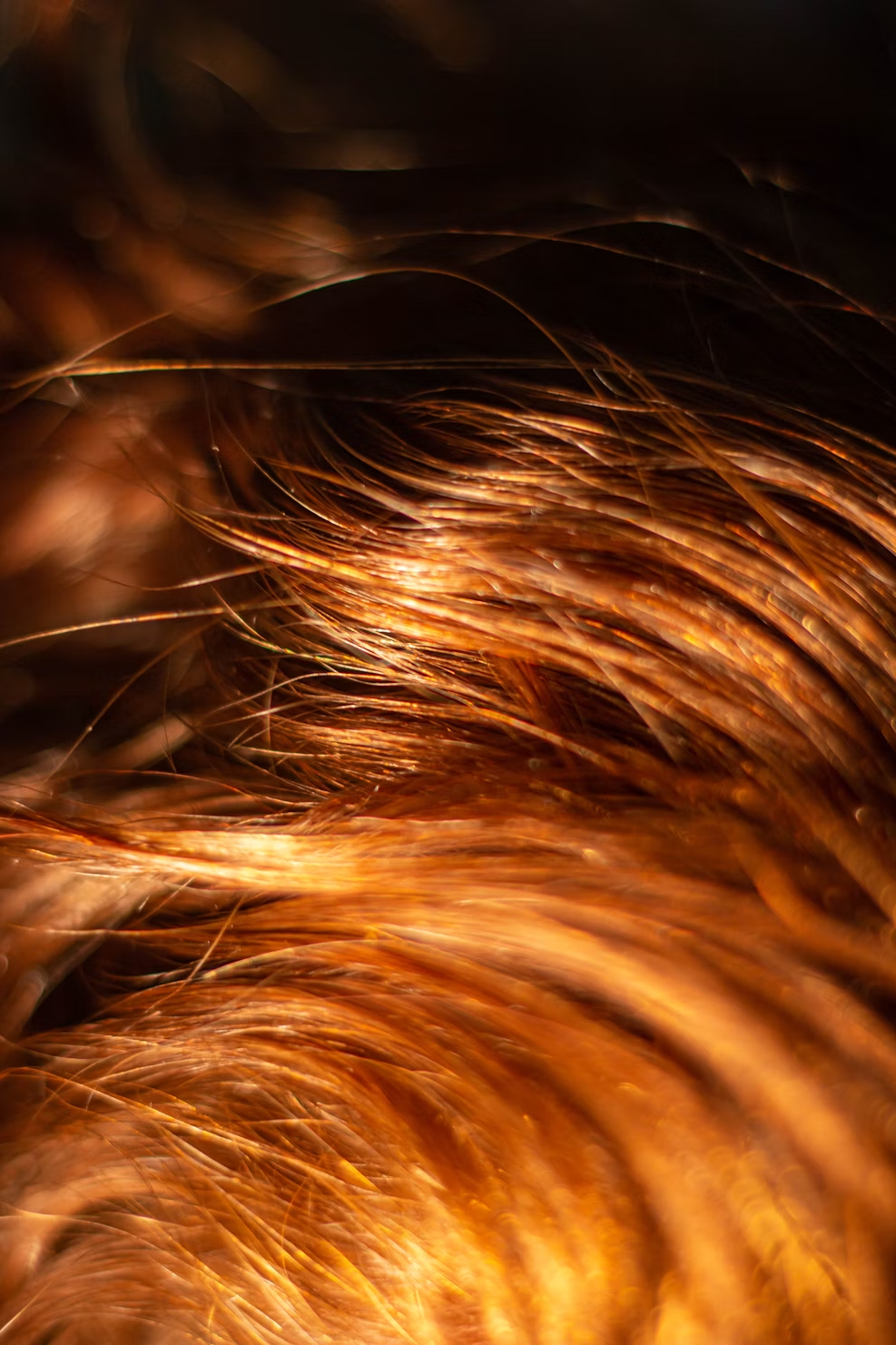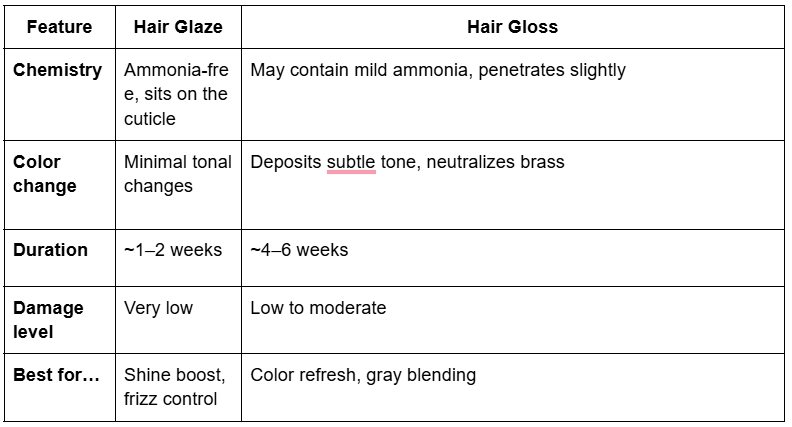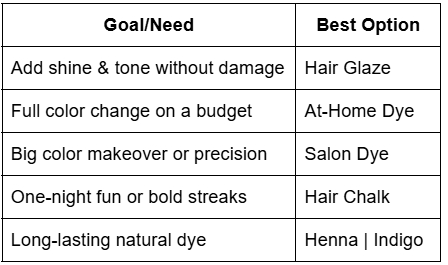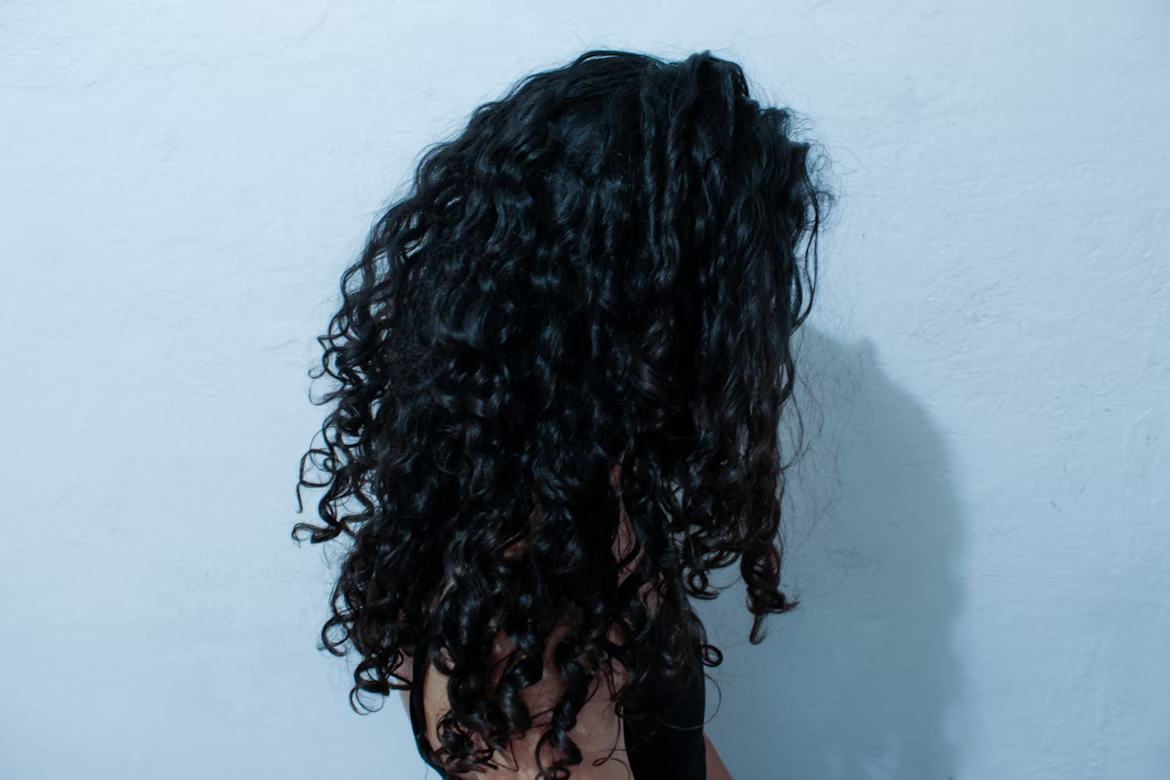f you've ever left a salon with hair so shiny you could use it as a mirror, chances are you’ve experienced a hair glaze (it’s also sometimes called a hair gloss). It's a semi-permanent, low-commitment treatment that does more than just add shine—it smooths frizz, enhances tone, and even nourishes strands without the damage of more traditional coloring techniques.
In this post, we’ll dive into:
- What a hair glaze is (and how it differs from gloss)
- The science behind it
- Who it’s for—and how it works
- How long do results last, and how to maintain them
- When to choose a glaze vs. more permanent coloring
1. What Is Hair Glaze?
At its core, a hair glaze is a gentle, ammonia- and peroxide-free coating that sits on top of the hair cuticle. Unlike permanent dyes, it doesn’t penetrate deep into the hair, meaning no lift (no lightening effect) and minimal chemical alteration.
Instead, it provides:
- High-shine glossiness
- Smoothness is achieved by flattening the cuticle layer
- Subtle color toning, often to neutralize brassiness or enhance current shade.
Most salon glazes are semi-transparent dyes with an acidic pH, helping to seal and smooth hair in much the same way cold water does—but with added color and conditioning benefits.
2. Hair Science 101: How It Works
To understand how glaze treatments work, let's take a quick detour into cosmetic chemistry:
- The hair cuticle is the hair’s outer layer—rough when damaged, smooth when healthy. Acidic formulas close the cuticle, making hair appear shiny and feel smoother. Here’s an explanation of how cosmetic products interact with hair structure.
- Because glazes don’t contain dyes that enter the cortex, they coat rather than alter the hair structure, so low damage, fast results.
- They're formulated by cosmetic chemists who understand emulsions, pH balance, and ingredient synergy—often studying in university programs (e.g., Wilson College of Textiles or UC’s Cosmetic Chemistry workshops).
3. Who Should Use Hair Glaze—and Why
Hair glaze treatments are ideal for anyone seeking:
- A shine boost, especially for dull or dry-looking strands.
- Frizz control, thanks to cuticle smoothing.
- A tonal refresh—like neutralizing brass in highlighted hair or adding depth to natural tones.
- A non-committal color tweak—no permanent dye, so no harsh lines or intense upkeep.
- Very fragile or chemically sensitive hair, since glazes skip harsh chemicals like ammonia or peroxide.

4. Salon vs. At-Home Glazes: What to Expect
In the Salon
- Applied to damp, pre-washed hair and processed for 10–20 minutes.
- Results typically last 1–2 weeks for glazes, and around 4–6 weeks for gloss treatments.
- Offers professional-grade color-toning, more customized shades, and even longer-lasting outcomes.
At Home
- Many clear or pigmented glaze kits are available for consumer use—gentle and easy to apply.
- Perfect for quick shine fixes between salon visits, though coverage and longevity may vary.
- Gloss treatments typically require professional mixing and timing due to their demi-permanent nature.
If you’ve decided to do your glaze at home here’s some music to bop and jam out to!
5. Glaze vs. Gloss: What’s the Difference?

In beauty expert terms: glaze is like a temporary stain, while gloss gives subtle color lift with shine and smoothness. Wanna learn more about the differences between hair glaze and hair gloss?
Pros and Cons compared to other methods or products
Whether you want to boost shine, deepen your natural tone, or experiment with color, there are multiple ways to get there. Hair glaze is one of the gentler options—but how does it stack up to other methods like box dye, salon color, temporary chalks, or henna? Here’s a breakdown to help you decide what’s best for your hair goals and lifestyle.
🌟 Hair Glaze
Semi-permanent treatment that adds shine and subtle tone without penetrating the hair shaft.
Pros:
- No ammonia or peroxide (gentle on hair)
- Enhances shine and softness
- Slight color boost or tone correction (like toning brassiness)
- Fades gradually, no harsh regrowth line
- Ideal for a "refresh" between salon visits
Cons:
- Doesn’t lighten hair or drastically change color
- Lasts 1–4 weeks depending on formula and washing
- May not show up well on very dark hair unless pigmented
Choose if: You want a shine boost, subtle color refresh, or brass neutralization without damage.
🏠 At-Home Box Dye
Permanent or semi-permanent color kits with varying chemical strengths.
Pros:
- Affordable and accessible
- Can lighten or darken dramatically
- Long-lasting (especially permanent dyes)
Cons:
- Risk of uneven application or unexpected results
- Contains ammonia or peroxide (more damaging)
- Can dry out or weaken hair if overused
Choose if: You want major color change and are confident with DIY or on a tight budget.
Pro tip: Get your hair dye from places like Sally’s Beauty Supply, where you can get developer to activate dye tubes, which tend to be less damaging to hair.
✂️ Salon Dye
Custom color treatment applied by professionals, often with high-quality ingredients.
Pros:
- Expert formulation and application
- Access to more complex techniques (balayage, highlights, tone blending)
- Can drastically transform or fine-tune color
- Usually includes bond-protecting products (like Olaplex)
Cons:
- Expensive, especially with maintenance
- Involves chemicals (potential for damage if mismanaged)
- Time-consuming
Choose if: You want precision, big color changes, or custom tonal work with less risk.
🎨 Hair Chalks / Temporary Markers
Pigmented sticks, sprays, or pens that sit on the surface of the hair.
Pros:
- Zero commitment—washes out in 1 shampoo
- Fun for events or festivals
- Safe for kids and all hair types
Cons:
- Can transfer to clothes/pillows
- Not great on very dark hair
- Temporary and may feel dry or gritty
Choose if: You want playful color without the commitment—great for a night out or photoshoot.
🌿 Henna (and Indigo)
Plant-based powders that stain the hair shaft with long-lasting, natural pigments.
Pros:
- 100% natural (no synthetic chemicals)
- Conditions hair and adds shine
- Lasts much longer than semi-permanent dyes
- Henna = reddish tones; henna + indigo = brown to black tones
Cons:
- Limited color range (can’t lighten)
- Time-consuming and messy to apply
- Once applied, hard to remove or dye over chemically
- Some commercial blends may contain metallic salts (check labels)
Choose if: You want a natural, long-lasting option and don’t plan to use chemical dyes soon after.
🧠 TL;DR: What’s Best for You?

6. Tips to Make Your Glaze Last Longer
- Wash with color-safe, sulfate-free shampoos and cool water to preserve shine and tone.
- Schedule a refresh every 1–2 weeks at home, or every 4–6 weeks in-salon.
- Use gloss-friendly haircare products—masks and conditioners that support cuticle health.
- Avoid heat over-styling, or always use a heat protectant before using irons or dryers.

7. Is Hair Glaze Safe?
Yes, for most people, hair glaze is considered one of the gentlest color-enhancement treatments available. Unlike permanent dyes or bleach, it doesn't contain ammonia or peroxide, which are the harsh chemicals often responsible for damaging hair structure or irritating the scalp. Instead, glaze sits on top of the hair shaft rather than penetrating it, making it a far less invasive option for adding shine, tone, or subtle color.
That said, no product is completely risk-free, especially when it comes to individual sensitivities. The main concern with any new product is the potential for an allergic reaction, particularly if you’ve had skin or scalp sensitivities in the past. Ingredients like fragrances, preservatives, or colorants—even in gentler formulas—can sometimes trigger itching, redness, or irritation. That’s why a patch test 24–48 hours before your appointment or at-home use is always recommended. Many salons will perform one upon request, and DIY kits often include patch test instructions.
If you have a sensitive scalp, eczema, psoriasis, or any dermatological condition, it’s best to talk with your stylist or a dermatologist before applying a glaze. Some formulas labeled “natural” or “ammonia-free” might still contain ingredients that exacerbate skin conditions. A professional can help guide you toward a brand or formulation that aligns with your needs, or recommend a treatment schedule that avoids triggering flare-ups.
If you don’t have a dermatologist or want to learn about specific ingredients check out the basic chemistry of hair cosmetics.
And remember: “gentle” doesn’t mean ineffective. A high-quality glaze can deliver serious shine, help refresh your tone, and even smooth frizz—all with minimal commitment and minimal risk.
Final Thoughts: Is Hair Glaze Right for You?
If what you want is shine, smoothness, and a subtle tone boost—without chemical stress or long-term commitment—hair glaze is an ideal choice. It’s:
- Quick (under 30 mins),
- Low-risk,
- Salon-friendly, and
- Great for keeping your color looking fresh between major treatments.
Interested in learning more about haircare or want more things to try out? Check out our post about quality haircare on a budget!















